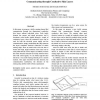19 search results - page 3 / 4 » From Indentation Shapes to Code Structures |
BMCBI
2005
13 years 4 months ago
2005
Background: Protein kinases are a well defined family of proteins, characterized by the presence of a common kinase catalytic domain and playing a significant role in many importa...
POPL
1993
ACM
13 years 8 months ago
1993
ACM
e data structures are abstractions of simple records and pointers. They impose a shape invariant, which is verified at compiletime and exploited to automatically generate code fo...
ICRA
2002
IEEE
13 years 9 months ago
2002
IEEE
In this paper, we propose a tactile sensing element that communicates through two dimensional conductive skin layers without individual wires. Each tactile element has sensors and...
ICFEM
2010
Springer
13 years 3 months ago
2010
Springer
Abstract. Verification of programs with invocations to unknown procedures is a practical problem, because in many scenarios not all codes of programs to be verified are available...
SOFTVIS
2010
ACM
13 years 4 months ago
2010
ACM
Understanding the data structures in a program is crucial to understanding how the program works, or why it doesn't work. Inspecting the code that implements the data structu...

